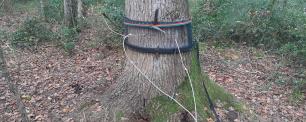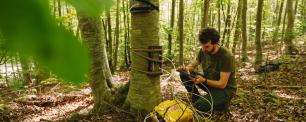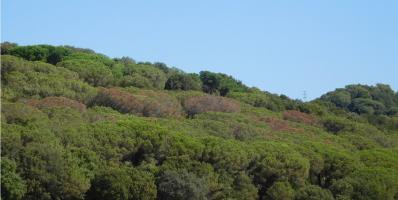MEMED
Methane fluxes from Mediterranean forests: from soils to stems and leaves across a soil water availability gradient
Field study to determine methane emissions in Mediterranean vegetation along a gradient of climatic conditions. The study will consist of three experimental areas that will be visited monthly for one year, over three consecutive years. The experimental areas are Tordera (Selva), Requesens (Alt Empordà), and Prades (Conca de Barberà).
For the measurements, portable gas analyzers will be used, so there will be little laboratory work at the CREAF. The experimental part of the project is planned for the first three years, leaving the data analysis and the preparation of the results for the fourth year.
Methane (CH4) is the second most important greenhouse gas in the atmosphere, with a warming potential 30 times greater than that of CO₂. Its atmospheric concentration has drastically increased since the pre-industrial era and is currently experiencing the highest rate of increase in recent decades, compromising our ability to meet the Paris Agreement target of limiting global temperature rise to 2 °C.
However, its atmospheric concentration is so variable in the short term that we cannot accurately determine the contribution of each component of the global CH4 cycle (sources and sinks). Over the last decade, it has been demonstrated that vegetation can play a crucial role in the CH4 cycle, with a significant contribution at regional scales, but this contribution has not yet been incorporated into global models.
It is known that trees growing in wetlands and flooded areas can act as conduits for methane produced in anoxic soils. However, it has also been observed that trees in forests with well-aerated soils can emit CH4 into the atmosphere. This emitted methane may be produced in deeper soil layers or within tree trunks by the activity of methanogenic archaea.
There is also evidence that methanogenic communities living in tree bark can oxidize part of the CH4, creating a spatially heterogeneous emission pattern. Trunk CH4 fluxes have been observed in forests from tropical, temperate, and boreal ecosystems, and they appear to be controlled by hydrology. Nevertheless, this hypothesis has not been thoroughly tested because fluxes have only been studied in ecosystems without water limitations.
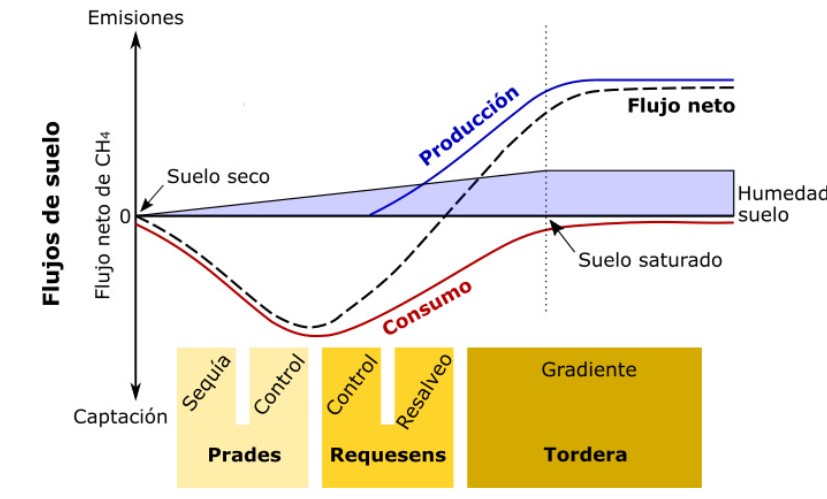
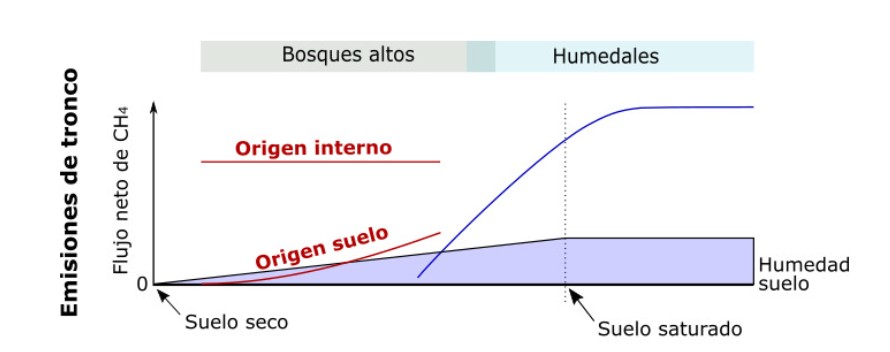
Expected response of CH4 production, consumption, and net fluxes at the base of tree trunks and soils along a hydrological gradient. The distribution of the sampling areas proposed in this project is shown at the bottom of this figure.
Objectives
This project will investigate CH4 fluxes from vegetation and soils in three Mediterranean forests, distributed along a gradient of water availability, ranging from a seasonally flooded forest to a forest subjected to long-term experimental drought treatment.
Our objectives are:
- Quantify, for the first time in Mediterranean forests, CH4 fluxes from vegetation.
- Describe the spatiotemporal patterns of CH4 fluxes from vegetation (measuring from the trunk base to the leaves).
- Compare vegetation fluxes with the CH4 sink capacity of soils (the only recognized actor in the CH4 cycle in these ecosystems).
- Determine how water conditions affect CH4 fluxes from vegetation and soil.
To achieve these objectives, we will measure CH4 fluxes from vegetation and soil through monthly and seasonal campaigns in the three Mediterranean forests. This gradient of water availability represents ideal conditions for testing the effects of hydrology and drought conditions on CH4 fluxes in Mediterranean vegetation.
In the context of increasing atmospheric CH4 concentrations contributing to global warming, and under a scenario of widespread water limitations, studying CH4 fluxes from vegetation and soils in Mediterranean forests could make a significant contribution to understanding the functional responses of forests to global change.

Measurements of methane fluxes at different heights of the trunk in a Mediterranean beech forest (Photo: Galdric Mossoll).
Proyecto PID2023-153031NA-I00 financiado por MICIU/AEI/10.13039/501100011033 y por FEDER, UE







